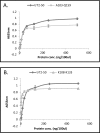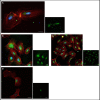Human RNASET2 derivatives as potential anti-angiogenic agents: actin binding sequence identification and characterization
- PMID: 25815360
- PMCID: PMC4341462
- DOI: 10.18632/oncoscience.100
Human RNASET2 derivatives as potential anti-angiogenic agents: actin binding sequence identification and characterization
Abstract
Human RNASET2 (hRNASET2) has been demonstrated to exert antiangiogenic and antitumorigenic effects independent of its ribonuclease capacity. We suggested that RNASET2 exerts its antiangiogenic and antitumorigenic activities via binding to actin and consequently inhibits cell motility. We focused herein on the identification of the actin binding site of hRNASET2 using defined sequences encountered within the whole hRNASET2 protein. For that purpose we designed 29 different hRNASET2-derived peptides. The 29 peptides were examined for their ability to bind immobilized actin. Two selected peptides-A103-Q159 consisting of 57 amino acids and peptide K108-K133 consisting of 26 amino acids were demonstrated to have the highest actin binding ability and concomitantly the most potent anti-angiogenic activity. Further analyses on the putative mechanisms associated with angiogenesis inhibition exerted by peptide K108-K133 involved its location during treatment within the HUVE cells. Peptide K108-K133 readily penetrates the cell membrane within 10 min of incubation. In addition, supplementation with angiogenin delays the entrance of peptide K108-K133 to the cell suggesting competition on the same cell internalization route. The peptide was demonstrated to co-localize with angiogenin, suggesting that both molecules bind analogous cellular epitopes, similar to our previously reported data for ACTIBIND and trT2-50.
Keywords: RNASET2; actin-binding; antiangiogenesis; peptides; ribonuclease.
Figures






Similar articles
-
Human recombinant truncated RNASET2, devoid of RNase activity; A potential cancer therapeutic agent.Oncotarget. 2014 Nov 30;5(22):11464-78. doi: 10.18632/oncotarget.2562. Oncotarget. 2014. PMID: 25426551 Free PMC article.
-
A recombinant human RNASET2 glycoprotein with antitumorigenic and antiangiogenic characteristics: expression, purification, and characterization.Cancer. 2006 Dec 15;107(12):2760-9. doi: 10.1002/cncr.22327. Cancer. 2006. PMID: 17109444
-
The 1.8 Å crystal structure of ACTIBIND suggests a mode of action for T2 ribonucleases as antitumorigenic agents.J Med Chem. 2012 Feb 9;55(3):1013-20. doi: 10.1021/jm1015507. Epub 2012 Jan 31. J Med Chem. 2012. PMID: 22216760
-
Targeting tumor micro-environment for design and development of novel anti-angiogenic agents arresting tumor growth.Prog Biophys Mol Biol. 2013 Nov;113(2):333-54. doi: 10.1016/j.pbiomolbio.2013.10.001. Epub 2013 Oct 15. Prog Biophys Mol Biol. 2013. PMID: 24139944 Review.
-
[Angiogenin and its role in angiogenesis].Mol Biol (Mosk). 2001 May-Jun;35(3):349-71. Mol Biol (Mosk). 2001. PMID: 11443914 Review. Russian.
Cited by
-
RNase T2 in Inflammation and Cancer: Immunological and Biological Views.Front Immunol. 2020 Aug 13;11:1554. doi: 10.3389/fimmu.2020.01554. eCollection 2020. Front Immunol. 2020. PMID: 32903619 Free PMC article. Review.
-
Phosphatidic Acid Counteracts S-RNase Signaling in Pollen by Stabilizing the Actin Cytoskeleton.Plant Cell. 2018 May;30(5):1023-1039. doi: 10.1105/tpc.18.00021. Epub 2018 Apr 30. Plant Cell. 2018. PMID: 29716992 Free PMC article.
-
Epididymal RNase T2 contributes to astheno-teratozoospermia and intergenerational metabolic disorder through epididymosome-sperm interaction.BMC Med. 2023 Nov 22;21(1):453. doi: 10.1186/s12916-023-03158-1. BMC Med. 2023. PMID: 37993934 Free PMC article.
-
Expression, Location, Clinical Implication, and Bioinformatics Analysis of RNASET2 in Gastric Adenocarcinoma.Front Oncol. 2020 May 22;10:836. doi: 10.3389/fonc.2020.00836. eCollection 2020. Front Oncol. 2020. PMID: 32528897 Free PMC article.
-
Overexpression of Murine Rnaset2 in a Colon Syngeneic Mouse Carcinoma Model Leads to Rebalance of Intra-Tumor M1/M2 Macrophage Ratio, Activation of T Cells, Delayed Tumor Growth, and Rejection.Cancers (Basel). 2020 Mar 18;12(3):717. doi: 10.3390/cancers12030717. Cancers (Basel). 2020. PMID: 32197460 Free PMC article.
References
-
- Folkman J. Biology of Endothelial Cells. Vol. 27. Boston, MA: Springer US; 1984. pp. 412–428.
-
- Sheetz MP, Felsenfeld D, Galbraith CG, Choquet D. Cell migration as a five-step cycle. Biochem Soc Symp. 1999;65:233–43. - PubMed
-
- Roiz L, Smirnoff P, Bar-Eli M, Schwartz B, Shoseyov O. ACTIBIND, an actin-binding fungal T2-RNase with antiangiogenic and anticarcinogenic characteristics. Cancer. 2006;106:2295–308. - PubMed
-
- Morales-Ruiz M, Fulton D, Sowa G, Languino LR, Fujio Y, Walsh K, Sessa WC. Vascular endothelial growth factor-stimulated actin reorganization and migration of endothelial cells is regulated via the serine/threonine kinase Akt. Circ Res. 2000;86:892–6. - PubMed
-
- Folkman J. Angiogenesis: an organizing principle for drug discovery? Nat Rev Drug Discov. 2007;6:273–86. - PubMed
LinkOut - more resources
Full Text Sources
Other Literature Sources

